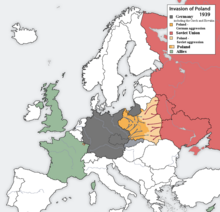Our website is made possible by displaying online advertisements to our visitors.
Please consider supporting us by disabling your ad blocker.
Invasion of Poland (1939)
| Invasion of Poland | |||||||||
|---|---|---|---|---|---|---|---|---|---|
| Part of World War II | |||||||||
 The map shows the beginning of the Second World War in September 1939 in a wider European context. | |||||||||
| |||||||||
| Belligerents | |||||||||
|
|
| ||||||||
| Commanders and leaders | |||||||||
|
(Ukrainian Front) |
| ||||||||
| Strength | |||||||||
|
Germany: Total: 1,500,000 Germans,[1] 466,516 Soviets,[3] 51,306 Slovaks Grand total: 2,000,000+ |
Poland: 39 divisions (some of them were never fully mobilized and concentrated),[4] 16 brigades,[4] 4,300 guns,[4] 880 tanks, 400 aircraft[1] Total: 950,000[Note 1] | ||||||||
| Casualties and losses | |||||||||
|
Germany:[Note 2] USSR:[Note 3] 1,475 killed or missing, 2,383 wounded |
Poland:[Note 4] 66,000 dead, 133,700 wounded, 694,000 captured | ||||||||
The Invasion of Poland in 1939 was a military offensive in which Nazi Germany and, two weeks later, the Soviet Union invaded Poland. That was the start of World War II in Europe.
The invasion started on 1 September 1939. The invasion of Poland caused the United Kingdom and France to declare war on Germany on 3 September, but they did little to affect the September Campaign. Fighting ended on 6 October. Germany and the Soviet Union conquered Poland and divided it according to their Molotov-Ribbentrop pact.
It is often called the first time that blitzkrieg was tried on the battlefield, but similar methods had been used earlier. The German surprise attack was successful and was very effective against the ineffective and demobilized Polish Army, whose tanks and airplanes were few and mostly old. The Poles were outflanked, outmaneuvered, and outnumbered in September 1939 and easily destroyed by the Germans. The Poles, if they had been well prepared, could have had two million soldiers in the fight.
In the first few days of the German invasion, Poland proved to be more difficult to invade than the Germans had expected. In the Battle[13] of Mokra on September 2nd, the Poles repulsed an attack by a German Panzer division and forced its retreat. The German air force, unlike in their invasions of other countries, did not easily overcome the outnumbered Polish Air Force. However, their great superiority in numbers made them gain air superiority after five to six days.
Surrounded by German territories north, west, and south of Poland, the Poles had little space for tactical retreat. The Germans reached Warsaw and attacked on September 7 but were repulsed. They had suffered heavy tank losses and so were forced to retreat.
The Battle of Bzura, on September 9, was the largest attack by the Poles during the war. The Poles had great initial success by decimating two German divisions and taking 3500 German prisoners. Polish infantry fought well, but by September 19, the overwhelming German reinforcements had defeated the Poles.
The Poles realized the British and French were in a phoney war and had no intention of assisting Poland, and the Soviet Red Army invaded Poland from the east on September 17. The Polish High Command ordered troops and equipment to the Romanian Bridgehead to enter Romania with the intention to continue their resistance by moving as much of their army to France as possible. Most of the Polish Navy escaped to Britain. Polish cryptographers who had cracked the German Enigma machine went to France and later to Britain, to continue their work.
Polish politicians set up a government-in-exile in France and later escaped to Britain. In 1945, when the Allied armies invaded Germany and forced its surrender, the Polish Army was the fourth largest allied army.
- ↑ 1.0 1.1 1.2 Ministry of Foreign Affairs. The 1939 CampaignPolish Ministry of Foreign Affairs, 2005 Archived 2013-12-11 at the Wayback Machine
- ↑ E.R Hooton, p85
- ↑ 3.0 3.1 Krivosheev, G.F. (1997). Soviet Casualties and Combat Losses in the Twentieth Century. Greenhill Books/Lionel Leventhal. ISBN 978-1-85367-280-4.
- ↑ 4.0 4.1 4.2 Переслегин. Вторая мировая: война между реальностями.- М.:Яуза, Эксмо, 2006, с.22; Р. Э. Дюпюи, Т. Н. Дюпюи. Всемирная история войн.—С-П,М: АСТ, кн.4, с.93
- ↑ Internetowa encyklopedia PWN, article on 'Kampania Wrześniowa 1939'
- ↑ Website of the Polish Ministry of Foreign Affairs – the Poles on the Front Lines
- ↑ 7.0 7.1 Wojna Obronna Polski 1939, page 851
- ↑ 8.0 8.1 "Polish War, German Losses". The Canberra Times. 13 Oct 1937. Archived from the original on 2009-06-30. Retrieved 2009-01-17.
- ↑ "Nazi Loss in Poland Placed at 290,000". The New York Times. 1941. Archived from the original on 2009-02-07. Retrieved 2009-01-16.
- ↑ 10.0 10.1 10.2 10.3 KAMIL CYWINSKI, Waffen und Geheimwaffen des deutschen Heeres 1933-1945
- ↑ Parkinson, Roger (1977). The Encyclopedia of Modern War. Stein and Day. p. 133. ISBN 978-0-8128-1898-7.
- ↑ "Axis Slovakia: Hitler's Slavic Wedge, 1938-1945", page 81
- ↑ "Awist.pl -Twój dostawca Internetu Internet Opatkowice, Kliny, Wieliczka, Kokotów, Śledziejowice, Gaj, Libertów, Lusina, Swoszowice, Chorowice, Skawina, Skotniki, Internet Wieliczka, Internet Śledziejowice, Internet Kokotów". www.awist.pl. Retrieved 2020-08-31.
<ref group=Note> tags on this page, but the references will not show without a {{reflist|group=Note}} template (see the help page).
Previous Page Next Page


